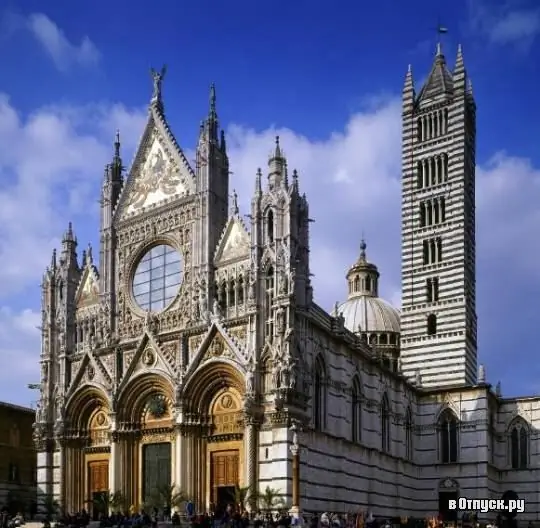
Description of the attraction
Siena Cathedral, dedicated to the Dormition of the Most Holy Theotokos, is the main medieval church in the city. It was built from 1215 to 1263 on the site of a previously existing temple. The origin of the latter remains a mystery and a reason for speculation. It is only known that once there was a 9th century church and a bishop's palace.
The modern Cathedral, built of white and greenish-black marble interspersed with red marble on the facade, has the shape of a Latin cross with a dome and an attached bell tower. The dome, resting on a hexagonal foundation and supported by columns, is decorated with a lantern by Bernini himself. The central nave of the church and two side chapels are separated from each other by semicircular arches.
In 1339, the second stage of construction of the cathedral began: it was planned to almost double its area by erecting a new nave and side chapels. However, the plague epidemic that broke out in 1348 prevented these plans from being realized. The outer walls, left over from this stage of work, can still be seen south of the cathedral. The foundation of the unfinished nave today serves as a car park and a testament to Siena's ambition and artistic achievement.
Below the cathedral's choir is a vestibule, which contains unique frescoes from the late 13th century depicting scenes from the Old Testament. Once these frescoes, discovered only during restoration work in 1999-2003, were part of the entrance portal to an early Christian church. The facade of the cathedral was also built in two stages. Its lower part is made of colored marble in the Tuscan Gothic style around the end of the 13th century. Architect Giovanni Pisano generously decorated it with gargoyles. He is also the author of three portals, crowned with arched openings and Gothic pediments. The columns between the portals are decorated with acanthus, allegorical figures and biblical scenes. Work on the upper part of the façade was resumed only in 1376. Its division into parts does not coincide at all with the division of the lower part, just as the pinnacles of both parts do not coincide. Almost all the statues that can be seen in the niches of the facade today are copies. The originals are kept in the Cathedral Museum.
The bronze central door was only made in 1958 by Enrico Manfrini. It is painted with scenes based on the Praise of the Virgin Mary. And three huge mosaics on the facade were made in Venice in 1878. Near the façade, you can see a column with a she-wolf feeding Romulus and Remus, the symbol of Siena. According to legend, it was the sons of Remus, Senius and Ascius, who were the founders of Siena.
Inside the cathedral, the large round stained glass made in 1288 deserves special attention - this is one of the very first examples of stained glass in Italy.






